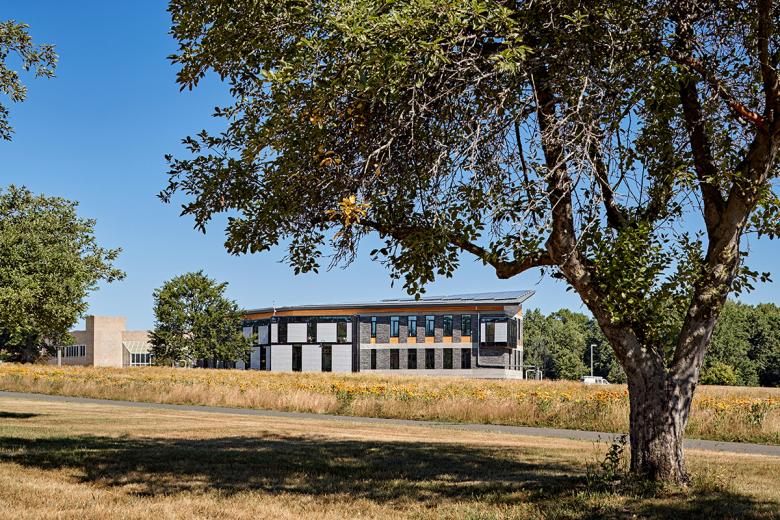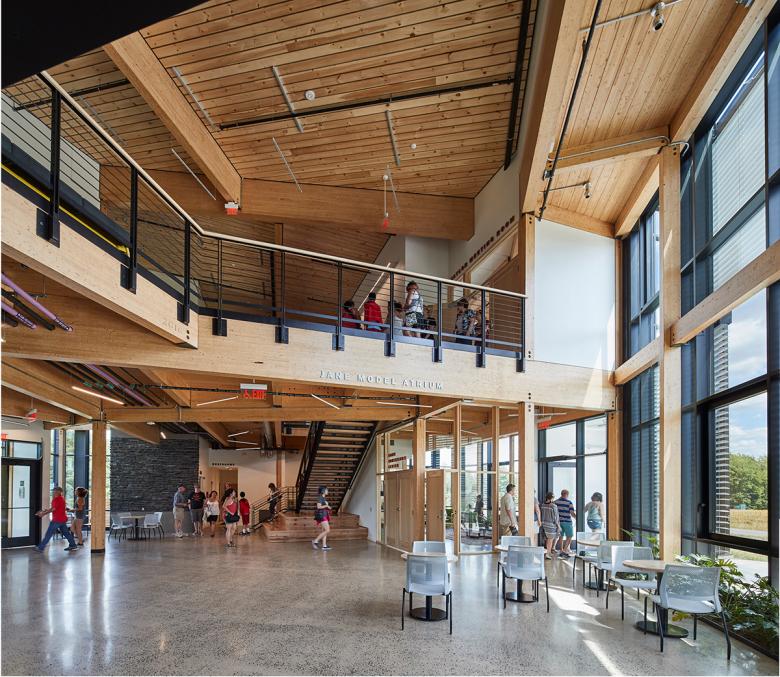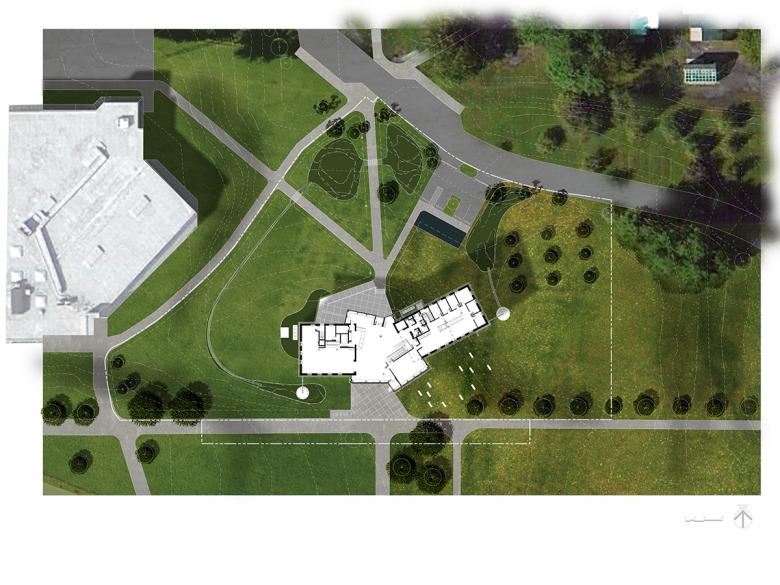Bruner/Cott
R.W. Kern Center
Bruner/Cott
30. April 2018
North elevation (Photo: Robert Benson Photography)
The International Living Building Institute’s Living Building Challenge is billed as "the world's most rigorous proven performance standard for buildings." Since its inception in 2006, fewer than twenty buildings have earned the stringent LBC Certification. The seventeenth and most recently certified building is the R.W. Kern Center at Hampshire College. Bruner/Cott answered a few questions about the building.
Project: R.W. Kern Center, 2017
Location: Amherst, Massachusetts, USA
Client: Hampshire College
Architect: Bruner/Cott Architects
Design Principal: Jason Forney, AIA, LEED AP
Project Architect/Manager: Jason Jewhurst, AIA
Project Team: Christopher Nielson, AIA, LEED AP; Sara Draper, Project Administrator
Structural Engineer: Foley Buhl Roberts & Associates
Mechanical, Plumbing, & Controls: Kohler & Lewis Engineers
Electrical Engineer: R.W. Sullivan
Fire Protection: Rybak Engineering
Landscape Architect: Richard Burck Associates
Lighting Designer: Lewis Lighting Design
Construction Manager: Wright Builders
Environmental Engineer: South Mountain Company
Code Consultant: Cutler Consulting
Commissioning Agent: Strategic Building Solutions
Estimating: AM Fogarty
Geotechnical Engineering: O'Reilly, Talbot & Okun Associates
Living Building Challenge: Coldham & Hartman Architects
LBC Material Vetting: Integrated Eco Strategy
Site/Civil & Permitting: Berkshire Design Group
Specifications: Kalin Associates
Site Area: 2.3 acres
Building Area: 17,000 sf
Aerial view from the northeast (Photo: Robert Benson Photography)
What were the circumstances of receiving the commission for this project?
Bruner/Cott was selected for this commission from among 40 entries in Hampshire College’s design competition for the project. The Kern Center is the result of an inclusive and integrated design process in which owner, design team, and contractor were all profoundly invested in the project’s mission and goals. The architect led numerous charrettes and visioning sessions to ensure that all members of the college community could contribute. The creation of the Center has also inspired a new series of curricula using the building as a living lab, with subjects including software engineering, biological studies, and social, economic, and political justice. The result is a building that connects fully to its place and exemplifies the college’s commitment to the highest level of environmental sustainability.
Aerial view from the southeast (Photo: Robert Benson Photography)
Please provide an overview of the project.
Located at the heart of the Hampshire College campus, the R.W. Kern Center became the 17th certified Living Building in the world in April 2018, meeting the most rigorous performance standard for sustainable buildings, and the largest certified higher education structure. The 17,000-sf, multi-purpose facility embodies a high threshold of forward-thinking sustainable design: generating its own energy, capturing and treating its own water, and processing and recycling its waste, while remaining sensitive to its campus and environmental context. The new building, which includes classrooms, offices, and a community café and gallery, serves as a primary entry point to the campus. It was designed to engage prospective students, provide community space, and showcase Hampshire’s commitment to the highest level of sustainability and stewardship by pursuing the rigorous Living Building Challenge (LBC), comprised of seven thematic performance areas and twenty specific benchmark imperatives for achievement. The new facility also aligns with the college’s mission of critical inquiry, active leadership, and hands-on learning.
South elevation (Photo: Robert Benson Photography)
What are the main ideas and inspirations influencing the design of the building?
The Kern Center was designed to create a positive impact across social, economic, and environmental boundaries. Inspired by its single rooftop array, the college scaled up to install a campus-wide PV system, saving money on utilities and improving community resilience. The project also inspired new courses exploring the building’s systems, mission, and meaning. The Center helped strengthen the local and global markets for sustainable and regional products, and minimized the building’s life-cycle costs with durable, low-carbon materials. It shows net positive action and impact — for the same cost as a similar "normal" building.
As the gateway to the college, the Center serves as a commons and public gathering space for interaction among all members of the community. The building project instigated a reworking of the original campus approach, converting the oval driveway in front of the site to a wildflower meadow. This intervention brought people and nature back to the center of campus, and created a pedestrian-centered place for students and visitors alike.
The impact of the Center is widespread. The building’s exposed systems, interpretive signage, and use in college curricula make it a powerful educational tool for visitors and students. Local tradespeople on the project gained valuable experience in material transparency and stewardship. On a global scale, the Center’s use of low-impact materials supported responsible industry and reduced total carbon emissions.
South elevation (Photo: Robert Benson Photography)
The Center was truly designed for people. Guided by the LBC principles of equity, beauty, and biophilia, it includes operable windows at all occupied spaces, providing access to daylight, views, and fresh air. A natural palette of wood and stone creates visual connection to the outdoors, and the commons’ planter- lined glass walls bring the outdoors in. Thermostats, lighting controls, and window shades are provided in most spaces to maximize individual thermal and visual comfort, and temperature-independent ventilation systems ensure adequate air circulation. Noise is controlled with an insulated cavity ceiling assembly built of mineral wool and pine planks. An open layout, generous interior glazing, double-height spaces, and an attractive central stair encourage people to move freely throughout the building.
The Kern Center is the result of an inclusive and integrated design process in which the college, design team, and contactor collaborated to solidify the project’s goals, mission, and strategies. Numerous charrettes and visioning sessions ensured that all members of the college community felt heard; students and faculty directly contributed in the form of “puzzle” installations, signage, and a digital dashboard. The Center vividly demonstrates Hampshire’s commitment to environmental sustainability, community-led action, and hands-on learning.
Detail of south elevation (Photo: Robert Benson Photography)
How does the design respond to the unique qualities of the site?
The major challenges posed by the project — designing a net-zero energy building in a cold climate; developing a rainwater-fed public water supply and a pilot project for indoor greywater treatment; and using only local, sustainable, and non-toxic materials — offered opportunities to create a unique building. Strategic use of window openings take advantage of signature views and daylight harvesting while maintaining a 30% window-to-wall ratio. Exposed cisterns, indoor greywater planters, and a landscaped raingarden are showcased as design features that teach water collection, treatment, and discharge, respectively. The Center’s aesthetic language features local stone and timber, connecting it to its dramatic mountain surroundings while also simplifying the materials palette to eliminate troublesome finishes and plastics.
Detail of south elevation at dusk (Photo: Robert Benson Photography)
The landscape surrounding the Center emulates the indigenous ecosystem, predominately in the form of a low-maintenance meadow. This meadow preserves native vegetation, creates an aesthetically pleasing campus feature, minimizes energy spent on maintenance, and supports a range of wildlife. A seed mix of 27 different wildflower species and two grasses accommodates the range of niche environments found on site and provide several layers of wildflowers to deter invasive weeds. Pollinator plants throughout the site attract bees and butterflies. In addition to the meadow, strategically placed rain gardens infiltrate 100 percent of rainwater on site, eliminating damaging run-off. Winter-bearing shrubs give structure to the rain gardens and provide fruit for small mammals and birds.
As part of the project, the college set aside 46 acres of land for permanent conservation and will also convert 1.6 acres of its existing conventional agricultural land to organic production to satisfy the LBC requirement for urban agriculture. Taken as a whole, the landscape, conservation, and cultivation efforts associated with the Kern Center significantly improve the local ecosystem for both humans and nature.
Lobby (Photo: Robert Benson Photography)
Was the project influenced by any trends in energy-conservation, construction, or design?
The Kern Center’s envelope maximizes thermal efficiency, incorporating both low-carbon and LBC- compliant materials. The building’s energy systems were designed specifically for a cold climate: passive solar orientation, robust insulation, an air-tight envelope, exterior shades, and triple glazed windows help mitigate swings in temperature and humidity typical of New England. The double-stud cavity wall and roof are filled with cellulose to achieve assembly values of R-40 and R-60, respectively. Tall operable windows help achieve a fully daylit building with a window to wall ratio of 30%. An inverter-driven heat pump system provides heating and cooling to the spaces, separate from the heat recovery ventilation system. By reducing the building’s design energy use, a rooftop solar array can generate more than enough energy on an annual basis.
The design team took advantage of the public nature of this welcome center by making the building an educational statement. The exposed electrical conduit, ductwork, and piping express the active and passive systems that combine to create a net zero energy building. In addition to the digital dashboard prominently displayed in the central commons and café space, information on the building’s systems and performance is available to campus visitors via a website and an on-site brochure.
Lobby (Photo: Robert Benson Photography)
What products or materials have contributed to the success of the completed building?
The Kern Center exemplifies an innovative, values-based approach to materials selection. Rather than designing the building and then choosing compatible materials and structural systems, the design team sought out the best available materials and designed the building around this palette. Materials were selected to meet the intersecting imperatives for local sourcing, responsible industrial practices, and avoidance of “red list” substances which have adverse effects on human health and the environment. The Center is clad in Ashfield schist veneer taken from a quarry located only 30 miles from campus and accented with a locally fabricated concrete. The interior of the building is defined by laminated timber beams made from sustainably forested wood and, on the first level, a polished concrete floor accented with local aggregate.
Second-floor gallery (Photo: Robert Benson Photography)
A natural palette of wood and stone creates visual connection to the outdoors, and the commons’ planter-lined glass walls bring the outdoors in. Thermostats, lighting controls, and window shades are provided in most spaces to maximize individual thermal and visual comfort, and temperature-independent ventilation systems ensure adequate air circulation. Noise is controlled with an insulated cavity ceiling assembly built of mineral wool and pine planks. An open layout, generous interior glazing, double-height spaces, and an attractive central stair encourage people to move freely throughout the building.
Materials were chosen to support the well-being of occupants, manufacturers, and installers. By following the LBC Red List, the team avoided chemicals of concern that negatively affect human health and the environment. Natural materials provide a good baseline, supplemented by Declare products and other carefully vetted systems and components. Use of low- or no-VOC finishes and furnishings minimized off-gassing; the construction manager even noted that the Center was the only project at which his crew preferred to eat lunch indoors.
Email interview conducted by John Hill.














